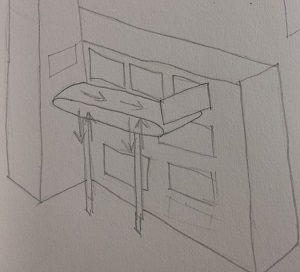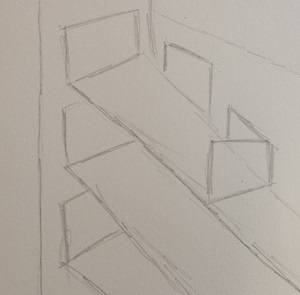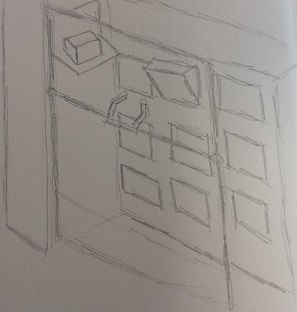Chimney to Cubby
| Project Trajectory | Project Pages | ||
|---|---|---|---|
| Home | Problem Definition | Opening | locker |
| Planning and Milestones | Background Research | Chimney | |
| Meetings | Requirements | Chimney to Cubby | |
| Design Method(s) | Brainstorm | Cubby to Person | |
| Personal Logs | Concepts Chosen | Software | |
Options
Notes:
- While the system is in the act of transporting a package, the sliding doors will not let any other package into the system.
- The system is equiped with a few sensors so that in case the package gets stuck somewhere, the system will have a good esimate of where it will be. These sensors are simple laser beams that if interrupted will send a signal, next to that the sensors that are already in use in the conveyor belt and the cubby can help locating.
Option 1

The chimney to cubby process consists of a conveyor belt capable of transporting packages in a horizontal direction. The belt itself can move in a vertical direction. Furthermore the conveyor belt has a weight sensor to measure if there is a package on it. The cubbies consist of two doors, one for getting the package into the cubbie, and for the user to take the package out. The only doors referred to on this page are the ones used to get the package in to the cubby. The cubbies are divided into rows and each cubbie has its own number.
When the package is at the sliding doors, it gets scanned. The system will now know who the package is addressed to and will choose a cubby. After confirming that all the cubby doors are closed the first step will be getting the conveyor belt to it's highest position to keep the falling distance of the package to a minimal. Once the belt senses a package is on it, it will move in vertical direction to the row assigned to the package. When the conveyor belt has arrived, the system will tell the cubby to open its door about 60 degrees. The conveyor belt with the package on it will start moving until it reaches the cubby. The open door will cause the package to automatically slide into the cubby. After the system has confirmed the package has arrived, the door will close and the conveyor belt will move back to its highest position.
Pros:
- A lot of cubbies can be reached
Cons:
- Very expensive
- Will require a lot of maintenance
- Not efficient with a high frequency of packages
Option 2

This method is similar to the previous one. The main difference is removing the ability of moving the conveyor belt in vertical direction which causes more costs and maintenance. Instead, there will be multiple conveyor belts above each other. This will require multiple exit points from the elevator.
Pros:
- Many cubbies can be reached
- Less expenses
Cons:
- Still not very cheap
- Will still require a lot of maintenance
Option 3

This method is similar to the previous one as it also uses multiple elevator exits. The difference is that instead of conveyor belts, it uses a slide. This will make the installation a lot cheaper, packages will simply move by gravity. This will of course require a different placement of cubbies. The placement will make it less space efficient.
Pros:
- A lot cheaper
- A lot less maintenance
Cons:
- Fewer cubbies
- Doors for getting packages into cubbie will need special shape
Option 4

Similar to some newer soda machines, this method uses a robot arm. The arm can move in two directions. First it retrieves the package from a platform where the elevator left it. The cubbie will open its door, not like a door in the previous ones, but with the opening at the top. The arm will the drop the package above the open cubbie.
Pros:
- Many cubbies can be reached
Cons:
- Expensive
- Requires a lot of maintenance
Chosen Concept
Considering all the pros and cons, expenses and maintenance, we decided to choose option 2, with multiple conveyor belts. The elevator will drop the package at the predefined level, the cubby will open its door and the conveyor belt will move the package to the opened door, sliding it into the cubby.
Scenario
We want our system to do more than just receiving packages for drones. We also want to use it for regular package delivery. This means that some of the lockers will be used for packages from drones and some will be used just by placing the package in from the front door. Some of these lockers will be bigger, to deliver packages that a drone cannot carry. Others will be simply used by people that do not want to pay extra for their delivery.
In 2013 around 120 million packages were delivered from companies to consumers in the Netherlands [1]
- ↑ Hoe krijgen we de 'last mile' op de rails? http://www.logistiek.nl/Supply-Chain/webwinkellogistiek/2013/6/Hoe-krijgen-we-de-last-mile-op-de-rails-1278708W/